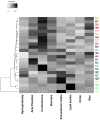Unveiling the Morphostructural Plasticity of Zoonotic Sporotrichosis Fungal Strains: Possible Implications for Sporothrix brasiliensis Virulence and Pathogenicity
- PMID: 37504690
- PMCID: PMC10381685
- DOI: 10.3390/jof9070701
Unveiling the Morphostructural Plasticity of Zoonotic Sporotrichosis Fungal Strains: Possible Implications for Sporothrix brasiliensis Virulence and Pathogenicity
Abstract
Sporotrichosis is a fungal infection caused by Sporothrix species, with Sporothrix brasiliensis as a prevalent pathogen in Latin America. Despite its clinical importance, the virulence factors of S. brasiliensis and their impact on the pathogenesis of sporotrichosis are still poorly understood. This study evaluated the morphostructural plasticity of S. brasiliensis, a fungus that causes sporotrichosis. Three cell surface characteristics, namely cell surface hydrophobicity, Zeta potential, and conductance, were assessed. Biofilm formation was also analyzed, with measurements taken for biomass, extracellular matrix, and metabolic activity. In addition, other potential and poorly studied characteristics correlated with virulence such as lipid bodies, chitin, and cell size were evaluated. The results revealed that the major phenotsypic features associated with fungal virulence in the studied S. brasiliensis strains were chitin, lipid bodies, and conductance. The dendrogram clustered the strains based on their overall similarity in the production of these factors. Correlation analyses showed that hydrophobicity was strongly linked to the production of biomass and extracellular matrix, while there was a weaker association between Zeta potential and size, and lipid bodies and chitin. This study provides valuable insights into the virulence factors of S. brasiliensis and their potential role in the pathogenesis of sporotrichosis.
Keywords: biofilm; biophysics; chitin; lipid bodies; one health; virulence factors.
Conflict of interest statement
The authors declare that the research was conducted in the absence of any commercial or financial relationships that could be construed as a potential conflict of interest.
Figures







References
Grants and funding
LinkOut - more resources
Full Text Sources

